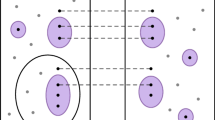Abstract
In 1974 R. Fagin proved that properties of structures which are in NP are exactly the same as those expressible by existential second order sentences, that is sentences of the form: there exist p→ such that φ, where p→ is a tuple of relation symbols and φ is a first order formula. Fagin was also the first to study monadic NP: the class of properties expressible by existential second order sen- tences where all the quantified relations are unary.
In [AFS00] Ajtai, Fagin and Stockmeyer introduce closed monadic NP: the class of properties which can be expressed by a kind of monadic second order exis- tential formula, where the second order quantifiers can interleave with first order quantifiers. In order to prove that such alternation of quantifiers gives substantial additional expressive power they construct graph properties P 1 and P 2: P 1 is ex- pressible by a sentence with the quantifier prefix in the class (∃∀)* ∃(∃∀)* 1 but not by a boolean combination of sentences from monadic NP (i.e with the prefix of the form ∃*(∃∀)*) and P 2 is expressible by a sentence ∃*(∃∀)* ∃*(∃∀)* but not by a Boolean combination of sentences of the form (∃∀)* ∃*(∃∀)*. A natural question arises here whether the hierarchy inside closed monadic NP, defined by the number of blocks of second order existential quantifiers, is strict.
In this paper we present a technology for proving some non expressibility results for monadic second order logic. As a corollary we get a new, easy, proof of the two results from [AFS00] mentioned above. With our technology we can also make a first small step towards an answer to the hierarchy question by showing that the hierarchy inside closed monadic NP does not collapse on a first order level. The monadic complexity of properties definable in Kozen’s mu-calculus is also considered as our technology also applies to the mu-calculus itself.
In this paper we use the symbols ∃, ∀ for the first order quantifiers and ∃, ∀ for the monadic second order quantifiers
Access this chapter
Tax calculation will be finalised at checkout
Purchases are for personal use only
Preview
Unable to display preview. Download preview PDF.
Similar content being viewed by others
References
M. Ajtai, R. Fagin, L. Stockmeyer The Closure of Monadic NP, (extended abstract of [AFS00]) Proc. of 13th STOC, pp 309–318, 1998
M. Ajtai, R. Fagin, L. Stockmeyer The Closure of Monadic NP, Journal of Computer and System Sciences, vol. 60 (2000), pp. 660–716
R. Fagin Monadic Generalized spectra, Zeitschrift fuer Mathematische Logik und Grundlagen der Mathematik, 21;89–96, 1975
M. de Rougemont Second-order and inductive definability on finite structures, Zeitschrift fuer Mathematische Logik und Grundlagen der Mathematik, 33:47–63, 1987
A. Ehrenfeucht an application of games to the completeness problem for formalized theories, Fund. Math. 49:129–141,1961
H-D. Ebinghaus, J. Flum Finite Model Theory, Springer 1995
R. Fraÿssé Sur quelques classifications des systemes de relations, Publ. Sci.Univ. Alger. Ser. A, 1:35–182, 1954
D. Kozen, Results on The Propositional μ calculus, Theor. Comp. Science, 27:333–354, 1983
J. Marcinkowski Directed Reachability: From Ajtai-Fagin to Ehrenfeucht-Fraisse games, Proceedings of the Annual Conference of the European Association of Computer Science Logic (CSL 99) Springer LNCS 1683, pp 338–349
O. Matz, W. Thomas The monadic quantifier alternation hierarchy over graphs is infinite, Proc. 12th IEEE LICS 1997, pp 236–244
Oliver Matz, Dot-Depth and Monadic Quantifier Alternation over Pictures, PhD thesis, report 99-8, Aachener Informatik-Berichte, RWTH Aachen, 1999
T. Schwentick Graph connectivity, monadic NP and built-in relations of moderate degree, Proceedings of 22nd ICALP: 405–416,1995
Author information
Authors and Affiliations
Editor information
Editors and Affiliations
Rights and permissions
Copyright information
© 2001 Springer-Verlag Berlin Heidelberg
About this paper
Cite this paper
Janin, D., Marcinkowski, J. (2001). A Toolkit for First Order Extensions of Monadic Games. In: Ferreira, A., Reichel, H. (eds) STACS 2001. STACS 2001. Lecture Notes in Computer Science, vol 2010. Springer, Berlin, Heidelberg. https://doi.org/10.1007/3-540-44693-1_31
Download citation
DOI: https://doi.org/10.1007/3-540-44693-1_31
Published:
Publisher Name: Springer, Berlin, Heidelberg
Print ISBN: 978-3-540-41695-1
Online ISBN: 978-3-540-44693-4
eBook Packages: Springer Book Archive




